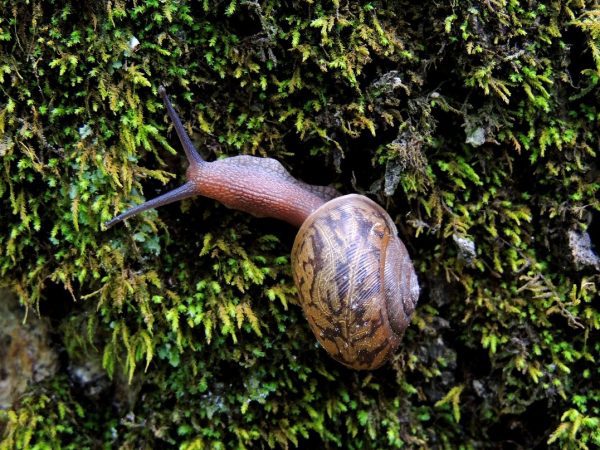What you didn’t know about slugs and snails

With damp spring rains, snails and slugs may be more visible in gardens and woods. North Carolina is home to more than 200 species of native terrestrial gastropods, 30-plus introduced species of land snails or slugs, and approximately 52 species of freshwater snails.
Snails are members of the phylum Mollusca and in the taxonomic class Gastropoda, as are slugs. There are 40,000 snail species – the largest group of living mollusks. Gastropods have a muscular foot used for movement and breathe through either lungs or gills.Snails have a single, spiral-coiled shell. Slugs lack a shell. Snails are born with their shells, though the shell of a baby snail, often referred to as a protoconch or “earliest shell,” is colorless and very soft. Baby snails must consume a lot of calcium to harden their shells and begin by eating the shell of the egg from which they hatched. As the snail grows, the shell grows with it. The snail grows new shell material, which then hardens. The small center of the spiral of a snail’s shell is the original protoconch.
All land snails and slugs are hermaphrodites, producing both spermatozoa and ova, which means all individuals have the potential to lay eggs. Some freshwater and marine snails have separate sexes. Some land snails move between land and fresh- or saltwater. Most land snails have lungs, but some live in moist areas and have gills.
Most snails have thousands of microscopic tooth-like structures on a ribbon-like tongue called a radula, which they use to rip apart food. Many snails are herbivorous (plant-eaters), but some are carnivores (meat-eaters) or omnivores (eating plants and meat). Some snails eat other snails.
I found one little snail sitting in the top of a pitcher plant near Black Ankle Bog. It is in the family Polygyridae – air-breathing land snails that characteristically have a thickened and somewhat reflexed edge at the opening of their shell. A friend of mine snapped a photo of another snail in the Uwharrie National Forest’s Badin Recreational Area. That species was Mesodon thyroidus, one of our larger species and one of the most common across the state.
I’m certain you’ve heard of escargot (snails) as a dish in French cuisine, but snails are also eaten in other countries including Nigeria, Italy, Vietnam, southwestern China and parts of the United States. Raising snails for food is called heliciculture. The eggs of some snails are also eaten, similar to caviar.
Seventy-four percent of all freshwater snails in the United States and Canada are imperiled, and conservation efforts for snails have lagged conservation efforts for other freshwater species. Better understanding is needed of snails, because only by understanding them can we hope to conserve them.